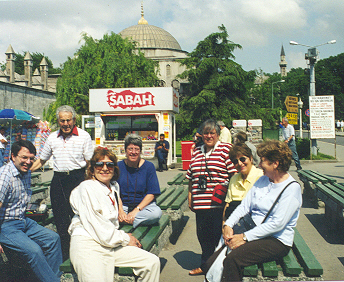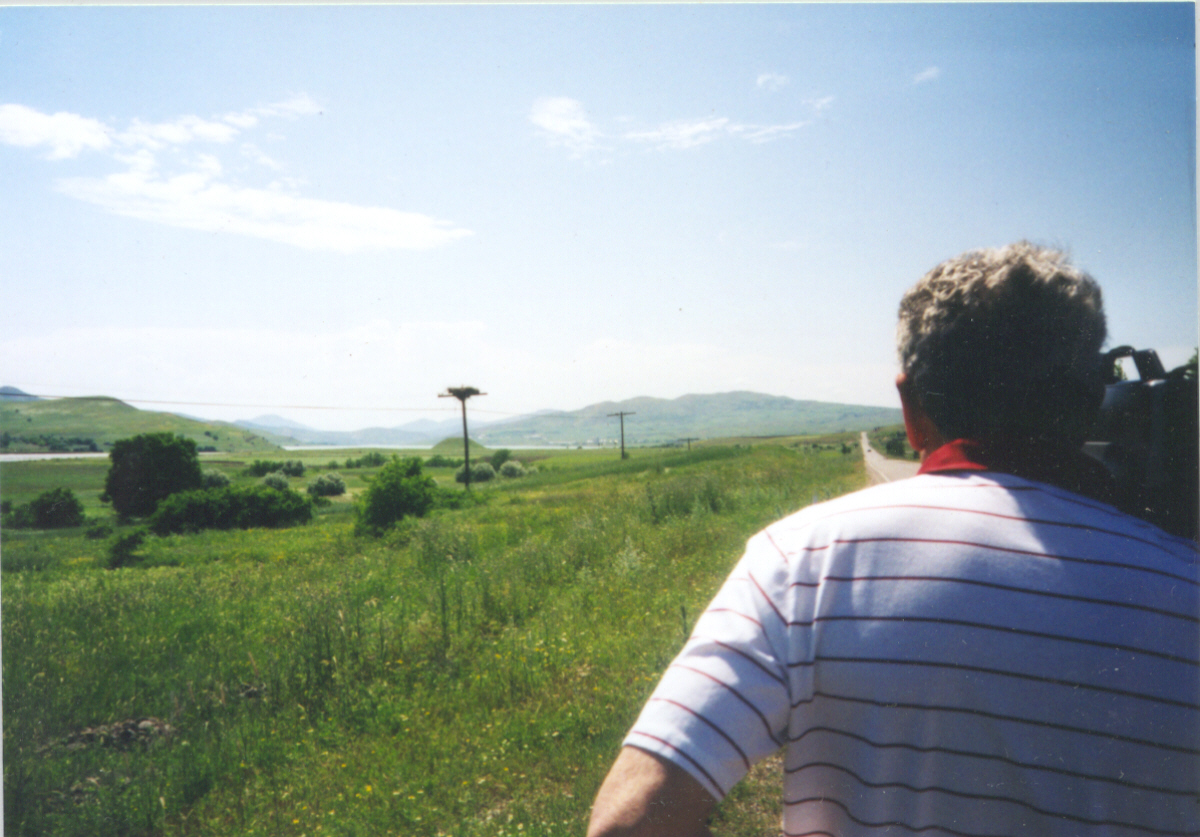In May and June 1998, John & Ellen
Poochigian along with their son, Dr. John Poochigian, Jr., and cousin, Ruth Poochigian,
visited the Armenian homeland of their forefathers. On their 20-day tour of Turkey,
they were accompanied by Ellen's cousin, Lucine Kebajian Krikorian, Haig Krikorian, and
family friend, Mary Anne.

Poochigian & Krikorian Group, Istanbul,
Turkey
From left: John
Poochigian, Jr., John Poochigian,
the guide, Mary Anne (friend), Ruth Poochigian
Lucine Krikorian & Ellen Keshish Poochigian
Photo taken by Haig Krikorian
John Poochigian is the son of Kevork "George" Poochigian (1896-1981) who migrated to America from Perri, Armenia, Turkey in 1913 (see Poochigian Migration) and Dikranouhi Sagerian Poochigian (1904-1996) who arrived in the United States from Adabazar (Adapazari), Turkey in 1921 (see Family Relationships). Ellen Keshish
Poochigian's mother, Haiganoush "Rose" Amerian Keshish (b. 1906) and grandparents were born in Dikranagert (Diyarbakir) Armenia,
Turkey (see Giragos
Amerian Family).
Ruth Poochigian is the
daughter of Boghos "Paul" Poochigian (1905-1949), who
immigrated to America from Perri, Armenia, Turkey in 1913 (see Poochigian
Migration) and Serpoohi
"Dorothy" Shamdanjian Poochigian (1910-1991) who migrated to the United States from Constantinople
(Istanbul), Turkey in 1913.
The Poochigian and Krikorian
group arrived in Istanbul, Turkey on May 17, 1998. While the group was in the
Istanbul area, John, Ellen and John, Jr. travelled about 50 miles (80 kilometers) to the
Black Sea port of Adabazar (Adapazari), Turkey, the birthplace of George's mother,
Dikranouhi Sagerian Poochigian. While in Istanbul, Ruth visited her Armenian
cousins, who live in Istanbul, and are related from her mother, Serpoohi
"Dorothy" Shamdanjian Poochigian's side of her family.
After spending two days in the Istanbul area, the group flew
to Adana, near the Mediterranean Sea, where they joined with their driver and
guide. Adana, one of Turkey's largest cities, is at the center of a rich agricultural
region and thriving textile industry. The Poochigian group then drove to the Old Testament
town of Sanliurfa (Urfa), the home of the Prophet Abraham. From there, they went to Diyarbakir (Dikranagert,
Diyarbakir, Diarbekir, Diarbekiar, Diyar Bakir, Amid), the birthplace of Ellen Poochigian's mother and
grandparents. Situated on the west bank of the Tigris (Dicle) River, Diyarbakir
is now the largest city in the
Southeastern Anatolia Region of Turkey. The province of Diyarbakir surrounds most of
the headwaters of the Tigris River.
All of us left Turkey
feeling how different
it could have been
if the Massacre
had not taken place
The Poochigian group visited Elazig and then Kharpert, where
the Armenian church is built partially underground in the mountain. John Poochigian
commented, "We climbed through a hole, about the size of a refrigerator, that led
into the church." John continued, "Kharpert College, which was
located on the side of a Mountain, no longer exists. The College was replaced with
housing and apartments."
From Kharpert, the Poochigian group travelled towards the
village of Perri, the birthplace of John Poochigian's father.
John Poochigian
When reflecting back on his visit to the outskirts of Perri, John said,
"I really wanted to see the place where my grandpa [Bedros Poochigian (1876-1960)] was from and my father [Kevork "George" Poochigian (1896-1981)] use to run around in the streets as a child."

John Poochigian, 1998
Looking toward the Perri River
& village of Perri,
the birthplace of John's father,
Kevork "George" Poochigian (1896-1981)
Photo taken by Haig Krikorian
John continued to describe their visit to Perri (Peri, Perry,
Parry, Pere, Perre) and the surrounding area,
"From Kharpert, we drove about two hours, 60 to
80 miles [97 to 128 kilometers], through a rural area. Along the way, there
were a few houses and herds of sheep walking on the highway. When we were about
three miles from Perri, the Turkish military police stopped us. They recommended
that we do not continue to drive into the village because the Kurds and Turks had a
skirmish in Perri the night before.
When we looked ahead toward the village of Perri, we could see
the roof tops on the houses. Perri is a village of an appreciable size of 500-1,000
people. The
low-frame houses in the Perri area are made of mud.
The residents of Perri,
and all of eastern Turkey, are made up of Kurds. Today, there's no Armenians left,
except just a few, and nobody really knows what an Armenian is. When we said, 'we're
Armenians, they said, what's that?'' A lot of people had never seen an
American."
The countryside around Perri, along the Perri River, is
very beautiful, with green rolling hills and high mountains off in the distance. The
area is very agricultural, with primarily ground vegetation and lots of livestock. The
farms are worked by women who are seen out in the fields. There are a few cows for milk,
but the livestock primarily consists of sheep that are raised, sold and butchered.
Around Perri, and in the countryside of Turkey, the people
travel in buses and cars, if they can afford them. Horse drawn wagons are also
used to transport people and farm goods.
John Poochigian, Jr.
When commenting about
Kharpert and the area around the town of Perri, John Poochigian, Jr., who also visited
Turkey in 1996, remarked:
"Eastern Turkey and
the area around the village of Perri probably hasn't changed much in the last 100 years.
The only difference is the residents of the area are now all Kurds. Most of the
province of Kharpert is now under water because of the artificial lakes.
Perri still exists,
however, it is now called "Akpazar." When we were trying to locate
"Perri," no one knew what we were talking about. We finally found
it. We drove east from Elazig, then north, then west toward Perri. We were stopped
about 3 miles east of Perri. This was where the road crossed over the Perri river. We took
our pictures of Perri from that point along the north bank of the Perri River. Perri
(Akpazar) was in the middle of the battlefield between the Turkish Army and the PKK
[the Kurdistan Workers Party] when we were there. If they ever settle that conflict,
it would be worth the effort to go back and walk the streets of Perri." (John Poochigian,
Jr. Interview)
The Perri River is a good
size body of water, large enough for the people to travel along the river in small boats
and trade their goods.
There are beautiful
green, rolling hills around Perri. The agrarian area around Perri, as well as most of
eastern Turkey, consists of farming, particularly growing grain crops and raising sheep.
There's negligible industry in the region.
The old city of Kharpert
is now Elazig. Today, what they refer to as "Harput" is an area on the top
of a mountain, which is surrounded by the city of Elazig.
Ellen Poochigian
Ellen Keshish Poochigian, wife of John Poochigian, shared the
following impressions about their trip to our Turkey:
"Other than in Istanbul, there were few Armenians
left. In Diyarbakir, there were 12 Armenians in all. Istanbul has about
60,000 Armenians, 32 Armenian churches and 12 Armenian schools. In Diyarbakir, we visited
the huge Armenian church. The beautiful church cannot be used today because the
roof collapsed and needs repair. The rest of the country that we toured had
many beautiful churches, over a 1,000 years old, but for many years, no one had taken care
of them. It was very sad to see our churches in such conditions.
All in all, everyone on our tour felt it was a wonderful trip
and happy that we made it. Turkey is a place with a lot of natural beauty. For
example, Van Lake was magnificent. The hotel accommodations were fine. The food
fresh and delicious and very reasonable (255,000 Lire to a dollar). The Turkish
people that we were around were very pleasant and very hospitable to us. They did
not seem to care that we were Armenians, and some of the young people didn't know who
Armenians were.
Of course, as wonderful as the trip was, all of us had gone to
Turkey with a pain in our hearts and left Turkey feeling how different it could have been
if the Massacre had not taken place."
From the Perri area, the Poochigian group continued on to Mus,
Van, Kars, Erzurum, Ani, Ankara and back to Istanbul. Located in the highest
region in Turkey, the scenic Mus (Mush, Moush) Plain is the second largest plain in
Eastern Anatolia, after Igdir. Lake Van, the largest lake in Turkey, is a salt water
lake surrounded by high mountains. Kars is located on the Armenian border near the
the ancient city of Ani. Ani, the site of one of the ancient Armenian capitals, is
now a ghost town and a city in ruins.
The ancient city of Erzurum (Erzerum) was important commercially and
situated on the ancient caravan route from Armenia to Persia. Today, Erzurum, which
is located on a high plateau, is the largest province in Eastern Anatolia. The
modern city of Ankara is Turkey's capitol and the location of the U.S. Embassy (See The
U.S. Mission in Turkey).
The Poochigian group departed from Turkey on June 7, 1998.
Thank you John, Ellen and John Poochigian, Jr. for sharing
your impressions of Turkey and historical Armenia, the homeland of our Armenian
forefathers.
Updated 07/15/99 |